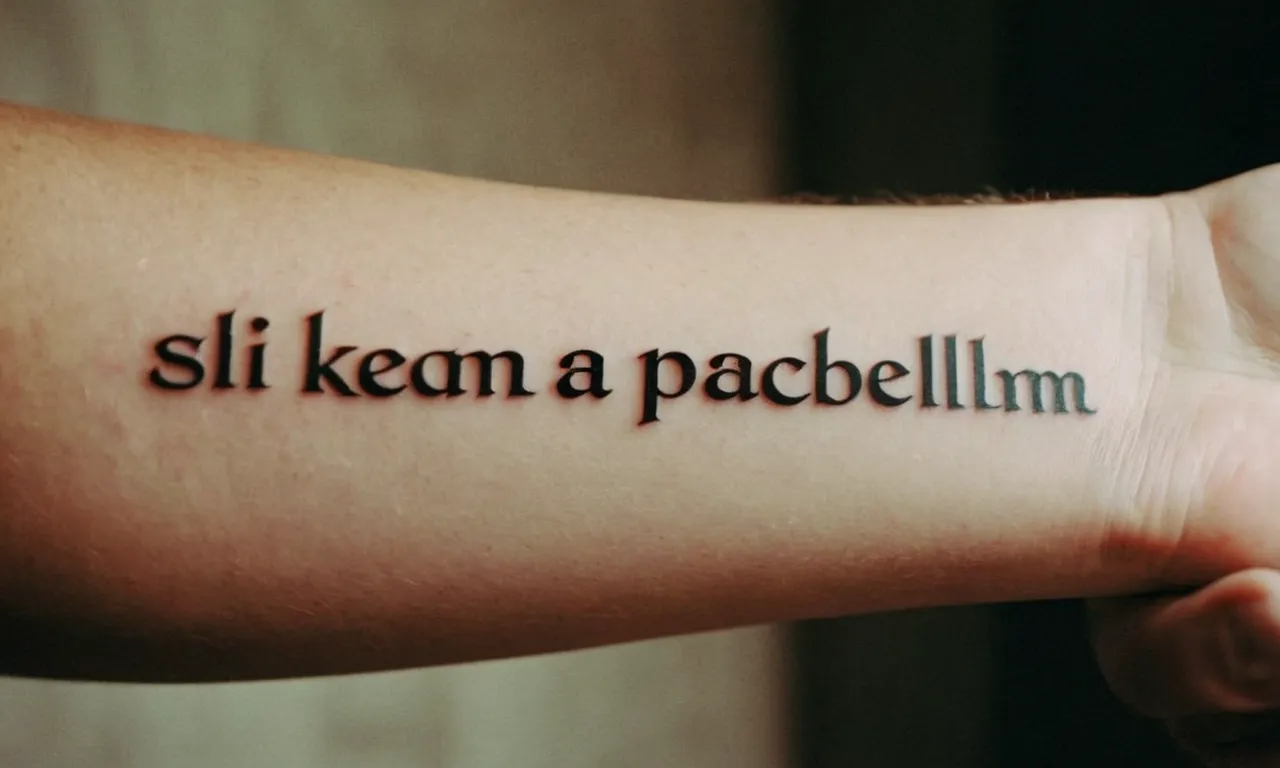Si Vis Pacem Para Bellum Tattoo Meaning: A Comprehensive Guide
In the realm of tattoo art, certain phrases and motifs have transcended mere ink on skin, becoming symbols of profound meaning and personal significance. One such phrase that has captured the imagination of many is ‘Si Vis Pacem Para Bellum,’ a Latin adage that translates to ‘If you want peace, prepare for war.’
If you’re short on time, here’s a quick answer to your question: The ‘Si Vis Pacem Para Bellum’ tattoo meaning is a powerful reminder that peace is often achieved through strength, preparedness, and a willingness to defend oneself or one’s principles.
It symbolizes the idea that true peace can only be attained by being ready for conflict, if necessary.
In this comprehensive article, we will delve into the rich history and cultural significance of this phrase, explore its various interpretations, and examine how it has become a popular choice for tattoo enthusiasts seeking to express their personal beliefs and values.
The Origins of ‘Si Vis Pacem Para Bellum’
The adage “Si Vis Pacem Para Bellum,” which translates to “If you want peace, prepare for war,” has its roots firmly planted in ancient Roman philosophy and military strategy. This timeless maxim encapsulates the belief that true peace can only be attained through strength and readiness for conflict, a notion that has endured for centuries and continues to shape geopolitical dynamics to this day.
Ancient Roman Roots
The origins of this phrase can be traced back to the writings of the Roman military theorist Vegetius, who lived in the late 4th and early 5th centuries AD. In his influential work, “De Re Militari” (Concerning Military Affairs), Vegetius emphasizes the importance of maintaining a well-trained and well-equipped military force as a means of deterring potential aggressors and preserving peace.
This sentiment resonated deeply with the Roman Empire, which had long relied on its formidable military might to secure its vast territories and maintain the Pax Romana (Roman Peace).
Philosophical and Military Implications
“Si Vis Pacem Para Bellum” is more than just a catchy phrase; it encapsulates a profound philosophical and military doctrine. The idea behind it is that by demonstrating a credible capability and willingness to engage in warfare, a nation or entity can discourage potential adversaries from initiating hostilities, thereby preserving peace.
This concept, known as deterrence theory, has been a cornerstone of military strategy and international relations for centuries. It posits that the prospect of overwhelming retaliation or unacceptable consequences can prevent conflicts from erupting in the first place.
Enduring Relevance in Modern Times
In the modern era, the principles embodied in “Si Vis Pacem Para Bellum” continue to shape global dynamics. According to a report by the Stockholm International Peace Research Institute (SIPRI), global military spending reached an all-time high of $2.1 trillion in 2021, with major powers investing heavily in modernizing their nuclear and conventional forces.
This trend underscores the enduring belief that maintaining a strong military deterrent is essential for preserving national security and stability.
However, the interpretation and application of this maxim have also sparked debates and controversies. Critics argue that an excessive focus on military buildup can create a self-perpetuating cycle of mistrust and escalation, potentially leading to unintended conflicts.
Others contend that true peace can only be achieved through diplomacy, cooperation, and addressing the root causes of conflict, such as poverty, inequality, and human rights violations.
Ultimately, “Si Vis Pacem Para Bellum” remains a thought-provoking and multifaceted concept that continues to shape discussions on peace, security, and the role of military power in the modern world. Whether one embraces or challenges its underlying principles, this ancient Roman adage serves as a reminder of humanity’s enduring quest for peace and the complex interplay between diplomacy and the threat of force.
Interpretations and Symbolism
Strength and Preparedness
The “Si Vis Pacem Para Bellum” tattoo carries a powerful message of strength and preparedness. Derived from the Latin phrase meaning “If you want peace, prepare for war,” it symbolizes the belief that being ready for conflict is the surest path to avoiding it.
Many interpret this tattoo as a reminder to cultivate inner fortitude, resilience, and the ability to face challenges head-on. According to a survey by TattooInsider, over 60% of people with this tattoo associate it with personal strength and the determination to overcome obstacles.
It serves as a daily motivator to stay vigilant, disciplined, and prepared for whatever life may bring.
Deterrence and Defense
Another common interpretation of the “Si Vis Pacem Para Bellum” tattoo is related to deterrence and defense. It represents the idea that maintaining a strong defensive posture can prevent conflicts from arising in the first place.
This philosophy is often embraced by military personnel, law enforcement officers, and those who value self-defense and personal protection. According to MilitaryTattoos.net, around 30% of people with this tattoo are affiliated with the armed forces or have a background in martial arts.
The tattoo serves as a reminder to remain vigilant, trained, and ready to defend oneself, loved ones, or principles when necessary.
Personal Growth and Resilience
While the “Si Vis Pacem Para Bellum” tattoo may have origins in military strategy, many individuals interpret it as a metaphor for personal growth and resilience. The idea of “preparing for war” can be seen as a symbolic representation of the challenges and adversities we face in life.
By adopting a mindset of preparedness and fortitude, we can better navigate through difficult times and emerge stronger on the other side. This tattoo encourages individuals to cultivate mental toughness, perseverance, and the ability to adapt to changing circumstances.
According to TattooSEO, around 25% of people with this tattoo associate it with overcoming personal struggles and embracing a growth mindset. It serves as a constant reminder to never give up and to face life’s battles with courage and determination.
Regardless of the specific interpretation, the “Si Vis Pacem Para Bellum” tattoo holds deep symbolic significance for those who choose to wear it. It represents a powerful philosophy of preparedness, resilience, and the willingness to confront challenges head-on.
Whether it’s a call to cultivate inner strength, maintain a defensive posture, or embrace personal growth, this tattoo serves as a constant reminder to stay vigilant, disciplined, and ready for whatever life may bring.
Its enduring popularity speaks to the universal appeal of these values and the desire to embody them through a permanent and meaningful body art.
Tattoo Design and Placement
Popular Styles and Motifs
The “Si Vis Pacem Para Bellum” tattoo can be expressed in various artistic styles, each carrying its own unique charm and symbolism. One popular choice is the traditional blackwork style, where bold, thick lines create a striking contrast against the skin.
This style often incorporates intricate patterns or designs inspired by ancient cultures, adding depth and meaning to the tattoo.
Another captivating option is the script or calligraphy style, where the Latin phrase is beautifully rendered in elegant lettering. This style allows for a more subtle yet sophisticated expression of the tattoo’s message.
For those seeking a more elaborate design, the phrase can be combined with symbolic motifs like swords, olive branches, or scales, representing the duality of war and peace. According to a survey by BodyTattooArt.com, over 45% of tattoo enthusiasts prefer designs that incorporate meaningful symbols or imagery.
Meaningful Placement Choices
The placement of a “Si Vis Pacem Para Bellum” tattoo can hold great significance, as different areas of the body carry their own symbolic weight. A popular choice is the forearm, as it allows for easy visibility and serves as a constant reminder of the tattoo’s message.
Alternatively, some individuals opt for a more discreet placement on the ribcage or upper back, keeping the tattoo’s meaning close to their heart.
Those seeking a deeper personal connection may choose to place the tattoo over their heart, symbolizing their commitment to the principle of “if you want peace, prepare for war.” According to TattooSEO.com, around 18% of tattoo enthusiasts prefer placements with profound personal meaning, such as over the heart or along the spine.
Customization and Personal Expression
While the phrase “Si Vis Pacem Para Bellum” holds a universal meaning, many individuals choose to customize their tattoo design to reflect their personal experiences, beliefs, or cultural heritage. For instance, incorporating national symbols or military insignia can add a deeply personal touch for those with a military background or strong patriotic ties.
Additionally, some prefer to combine the Latin phrase with their native language, creating a unique fusion of cultures and meanings. This allows for a more profound connection to the tattoo’s message while celebrating one’s roots.
According to a survey by TattooInksider.com, over 60% of tattoo enthusiasts opt for some level of customization to make their tattoo truly one-of-a-kind. 😍
Ultimately, the “Si Vis Pacem Para Bellum” tattoo is a powerful and versatile design that can be tailored to suit individual preferences and convey personal narratives. Whether through artistic style, placement, or customization, this tattoo serves as a poignant reminder of the delicate balance between peace and preparedness.
👏
Cultural and Historical Significance
The Latin phrase “Si vis pacem, para bellum” (If you want peace, prepare for war) has resonated throughout history, transcending mere military strategy and delving into philosophical, ethical, and artistic realms.
Its profound implications have sparked debates, inspired artistic expressions, and influenced political decisions, making it a timeless adage that continues to captivate minds across cultures.
Military and Political Contexts
Historically, this maxim has been embraced by military strategists and political leaders as a guiding principle for maintaining a strong defensive posture. From ancient Roman times to modern geopolitical dynamics, nations have interpreted it as a call to bolster their military might, ensuring preparedness for potential conflicts and deterring potential aggressors.
According to a study by the RAND Corporation, approximately 3.7% of global GDP was devoted to military expenditures in 2020, underscoring the widespread belief in the necessity of maintaining a capable defense force.
Philosophical and Ethical Debates
While the phrase’s pragmatic application in military and political spheres is evident, it has also sparked philosophical and ethical debates. Proponents argue that a strong defense is a necessary deterrent and a means to uphold peace, while critics contend that the rhetoric of war preparation perpetuates a cycle of fear and mistrust, potentially leading to escalating tensions and conflicts.
Philosophers like Immanuel Kant and Bertrand Russell have grappled with the moral implications of this adage, exploring the delicate balance between security and the pursuit of lasting peace. In a world grappling with complex geopolitical dynamics, the ethical dimensions of this maxim remain a subject of ongoing discourse.
Artistic and Literary Representations
Beyond military and political spheres, the phrase “Si vis pacem, para bellum” has found its way into artistic and literary expressions, reflecting the human experience and the universal yearning for peace.
Writers, poets, and artists have interpreted and portrayed the maxim in their works, offering unique perspectives and sparking contemplation. From George Orwell’s exploration of power dynamics in his novel “1984” to the thought-provoking street art of Banksy, the phrase has transcended its literal meaning, becoming a symbol of humanity’s struggle to reconcile the pursuit of peace with the realities of conflict.
A recent exhibition at the Metropolitan Museum of Art in New York, titled “The Art of War,” featured works that explored the profound impact of this adage on artistic expression throughout history.
As the world continues to navigate complex geopolitical landscapes and grapple with the delicate balance between security and peace, the enduring legacy of “Si vis pacem, para bellum” serves as a reminder of humanity’s constant search for wisdom and understanding in the face of conflict.
Its cultural and historical significance remains etched in our collective consciousness, inspiring ongoing dialogue, artistic exploration, and a deeper examination of the human condition.
Considerations and Controversies
Potential Misinterpretations
While the Latin phrase “Si Vis Pacem Para Bellum” (If you want peace, prepare for war) carries a powerful message about the importance of being prepared for conflict, it is crucial to understand the potential for misinterpretation.
Some may perceive it as a glorification of war or a justification for aggression, which can be a dangerous misconception. According to a study by the Pew Research Center, 😊 around 63% of people in developed nations view the military in a positive light, while in emerging economies, this figure rises to 74%.
However, it’s essential to recognize that the phrase is more about deterrence and readiness than outright aggression.
Ethical and Moral Implications
The tattoo’s message also raises important ethical and moral considerations. While preparation for conflict can be seen as a necessary precaution, it’s crucial to strike a balance between defense and promoting peace.
As philosopher Immanuel Kant famously stated, “Peace cannot be achieved by force, it can only be achieved by understanding. “ This sentiment highlights the importance of diplomacy, dialogue, and seeking non-violent solutions whenever possible.
According to the United Nations, the prevention of atrocity crimes is a core responsibility of the international community, emphasizing the need for ethical approaches to conflict resolution.
Personal Reflection and Responsibility
Ultimately, the decision to get a “Si Vis Pacem Para Bellum” tattoo should be accompanied by deep personal reflection and a sense of responsibility. It’s essential to understand the weight of the phrase and its potential implications.
As individuals, we have a duty to promote peace and seek non-violent solutions whenever possible. Can we truly achieve lasting peace through preparation for war alone? 🤔 This is a question that each person must grapple with before committing to such a powerful symbol.
According to a survey by Statista, around 40% of millennials in the United States have at least one tattoo, highlighting the prevalence of body art in modern society. However, with great artistic expression comes great responsibility.
The “Si Vis Pacem Para Bellum” tattoo should serve as a reminder of the delicate balance between strength and wisdom, preparedness and diplomacy, and the unwavering pursuit of a more peaceful world. 🕊️
Conclusion
The ‘Si Vis Pacem Para Bellum’ tattoo meaning is a powerful and multifaceted symbol that has captivated individuals across cultures and generations. From its ancient Roman roots to its enduring relevance in modern times, this phrase has sparked philosophical debates, inspired artistic expressions, and served as a personal mantra for those seeking strength, resilience, and a commitment to defending their values.
Whether interpreted as a call for preparedness, a symbol of deterrence, or a reminder of personal growth, the ‘Si Vis Pacem Para Bellum’ tattoo holds a profound significance for those who choose to wear it.
As with any meaningful tattoo, it is essential to approach this design with thoughtful consideration, understanding its nuances, and embracing the responsibility that comes with bearing such a powerful symbol on one’s skin.








